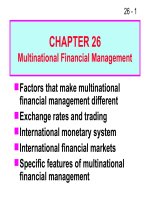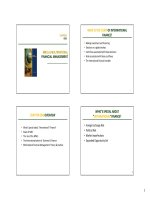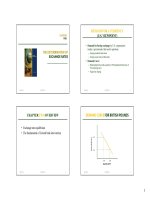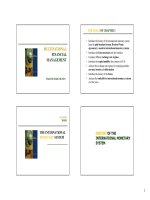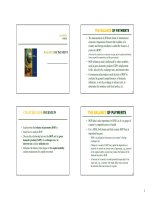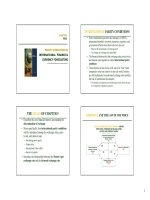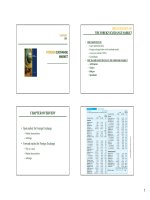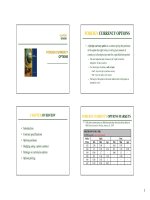Multinational financial management 7th CH18
Bạn đang xem bản rút gọn của tài liệu. Xem và tải ngay bản đầy đủ của tài liệu tại đây (719.5 KB, 31 trang )
Multinational Financial
Management
Alan Shapiro
7th Edition
J.Wiley & Sons
Power Points by
Joseph F. Greco, Ph.D.
California State University, Fullerton
1
CHAPTER 18
FINANCING FOREIGN
TRADE
2
CHAPTER OVERVIEW:
I.
PAYMENT TERMS
II.
DOCUMENTS
III.FINANCING TECHNIQUES
IV.
GOVERNMENT SOURCES OF
EXPORT FINANCING AND
CREDIT
INSURANCE
V.
COUNTERTRADE
3
I.
PAYMENT TERMS
I. PAYMENT TERMS
A. Five Principal Means:
1. Cash in advance
2. Letter of Credit
3. Drafts
4. Consignment
5. Open Account
4
PAYMENT TERMS
B. Cash in Advance
1. Minimal risk to exporter
2. Used where there is
a. Political unrest
b. Goods made to order
c. New unfamiliar
customer
5
PAYMENT TERMS
C. Letter of Credit (L/C)
1. A letter addressed to seller
a. written and signed by
buyer’s bank
b. promising to honor seller’s
drafts.
c. Bank substitutes its own
commitment
d. Seller must conform to terms
6
PAYMENT TERMS
2. Advantages of an L/C to
Exporter
a. eliminates credit risk
b. reduces default risk
c. payment certainty
d. prepayment risk protection
e. financing source
7
PAYMENT TERMS
3. Advantages of L/C to Importer
a. shipment assured
b. documents inspected
c. may allow better sales terms
d. relatively low-cost financing
e. easy cash recovery if
discrepancies
8
PAYMENT TERMS
4.
a.
b.
c.
d.
e.
f.
Types of L/Cs
documentary
non-documentary
revocable
irrevocable
confirmed
transferable
9
PAYMENT TERMS
D. DRAFTS
1. Definition:
- unconditional order in writing
- exporter’s order for importer
pay
- at once (sight draft) or
- in future (time draft)
10
to
PAYMENT TERMS
2. Three Functions of Drafts
a. clear evidence of financial obligation
b. reduced financing costs
c. provides negotiable and unconditional financial instrument
(ie. May be converted to a banker’s
acceptance)
11
PAYMENT TERMS
3. Types of Drafts
a. sight
b. time
c. clean (no documents
needed)
d. documentary
12
PAYMENT TERMS
E. CONSIGNMENT
1. Exporter = the consignor
2. Importer = the consignee
3. Consignee attempts to sell
goods to a third party; keeps some
profit, remits rest to consignor.
4. Use: Between affiliates
13
PAYMENT TERMS
F. OPEN ACCOUNT
1. Creates a credit sale
2. To importer’s advantage
3. More popular lately because
a. major surge in global trade
b. credit information improved
c. more global familiarity with
exporting.
14
PAYMENT TERMS
4. Benefits of Open Accounts:
a. greater flexibility in making
a trade
b. lower transactions costs
5. Major disadvantage:
highly vulnerable to government
currency controls.
15
II. DOCUMENTS
II. DOCUMENTS USED IN INT’L
TRADE
A. Four most used documents
1. Bill of Lading (most
important)
2. Commercial Invoice
3. Insurance Certificate
16
DOCUMENTS
B. Bill of Lading
Three functions:
1. Acts as a contract to carry
goods.
2. Acts as a shipper’s receipt
3. Establishes ownership over
goods if negotiable type.
17
the
DOCUMENTS
2.
a.
b.
c.
d.
e.
f.
Type of Bills
Straight
Order
On-board
Received-for-shipment
Clean
Foul
18
DOCUMENTS
C.
COMMERCIAL INVOICE
Purpose:
1. Lists full details of goods shipped
2. Names of importer/exporter given
3. Identifies payment terms
4. List charges for transport and
insurance.
19
DOCUMENTS
D.
INSURANCE
1.
Two Categories:
a.
Marine: transport by sea
b.
Air: transport by air
2.
Insurance Certificate
issued to show proof of
insurance
3.
All shipments insured today.
20
DOCUMENTS
E.
CONSULAR INVOICE
Local consulate in host country
issues:
• a visa for the exporter’s invoice
• requires fee to be paid to consulate
21
III. FINANCING TECHNIQUES
III. FINANCING TECHNIQUES
A. Four Types:
1. Bankers’ Acceptances
a. Creation: drafts accepted
b. Terms: Payable at
maturity to
holder
22
FINANCING TECHNIQUES
2. Discounting
a. Converts exporters’ drafts to cash
minus interest to maturity and
commissions.
b. Low cost financing with few fees
c. May be with (exporter still liable)
or without recourse(bank takes
liability for nonpayment).
23
FINANCING TECHNIQUES
3. Factoring
-firms sell accounts receivable to another
firm
known as the factor.
a.
Discount charged by factor
b.
Non-recourse basis: Factor
assumes all payment risk.
c.
When used:
1.)
Occasional exporting
2.)
Clients geographically
dispersed.
24
FINANCING TECHNIQUES
4. Forfaiting
a. Definition:
discounting at a fixed rate
recourse of medium-term
receivable denominated
convertible currency.
without
accounts
in a fully
b. Use: Large capital purchases
c. Most popular in W. Europe
25
